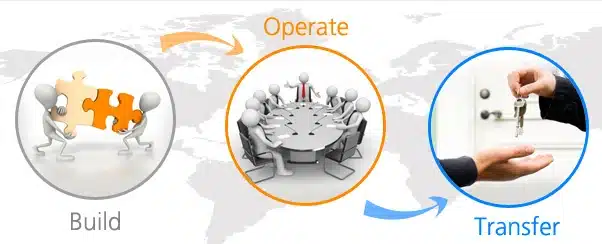About build-operate-transfer (BOT) Model
- It is a type of agreement often used in infrastructure projects, particularly in the construction and operation of public facilities or utilities.
- It is a conventional public-private partnership (PPP) model in which a private entity (usually a company or consortium) is granted the rights and responsibilities to design, finance, construct, operate, and maintain a specific project or facility for a defined period of time.
- The private entity, known as the “concessionaire” or “developer,” bears the financial and operational risks associated with the project during the contract period.
- The typical lifecycle of a BOT contract involves three phases:
- Build: The concessionaire is responsible for financing, designing, and constructing the infrastructure project. This phase usually includes obtaining the necessary permits and approvals.
- Operate: After the construction is completed, the concessionaire operates and maintains the facility for a specified duration. This can involve providing services, managing operations, and generating revenue from the facility (e.g., tolls, fees, or user charges).
- Transfer: At the end of the contract period, the ownership and control of the facility are transferred back to the government or public authority, which may have been the original owner. The transfer is often accompanied by a predetermined valuation or compensation mechanism.
- The private company gains revenue during the concession period, while the government benefits from infrastructure development without upfront investment.
- However, the specifics of the financial arrangements and incentives vary depending on the individual BOT contract.
- BOT is particularly well-suited for greenfield projects (new projects without prior work) and large-scale, capital-intensive projects.
Key Facts about National Highways Authority of India (NHAI)
- NHAI is India’s premier highway infrastructure creator, entrusted with developing, maintaining, and managing National Highways.
- It is a statutory body under the administrative control of the Ministry of Road Transport and Highways.
- It was constituted under the National Highways Authority of India Act, 1998, and made operational in February 1995.
- Composition: It consists of a full-time Chairman, and not more than five full time Members and four part-time members who are appointed by the Central Government.
- NHAI has technical, Finance, Administrative and Vigilance Wings at its Headquarters.
Q1) What is a consortium?
A consortium is a group made up of two or more individuals, companies, or governments that work together to achieve a common objective. Entities that participate in a consortium pool resources but are otherwise only responsible for the obligations that are set out in the consortium’s agreement. Every entity that is under the consortium, therefore, remains independent with regard to their normal business operations and has no say over another member’s operations that are not related to the consortium.
Source: EXPLAINER: Will the new BoT model bring back private developers?
Last updated on December, 2025
→ Check out the latest UPSC Syllabus 2026 here.
→ Join Vajiram & Ravi’s Interview Guidance Programme for expert help to crack your final UPSC stage.
→ UPSC Mains Result 2025 is now out.
→ UPSC Notification 2026 is scheduled to be released on January 14, 2026.
→ UPSC Calendar 2026 is released on 15th May, 2025.
→ The UPSC Vacancy 2025 were released 1129, out of which 979 were for UPSC CSE and remaining 150 are for UPSC IFoS.
→ UPSC Prelims 2026 will be conducted on 24th May, 2026 & UPSC Mains 2026 will be conducted on 21st August 2026.
→ The UPSC Selection Process is of 3 stages-Prelims, Mains and Interview.
→ UPSC Result 2024 is released with latest UPSC Marksheet 2024. Check Now!
→ UPSC Prelims Result 2025 is out now for the CSE held on 25 May 2025.
→ UPSC Toppers List 2024 is released now. Shakti Dubey is UPSC AIR 1 2024 Topper.
→ UPSC Prelims Question Paper 2025 and Unofficial Prelims Answer Key 2025 are available now.
→ UPSC Mains Question Paper 2025 is out for Essay, GS 1, 2, 3 & GS 4.
→ UPSC Mains Indian Language Question Paper 2025 is now out.
→ UPSC Mains Optional Question Paper 2025 is now out.
→ Also check Best IAS Coaching in Delhi

















